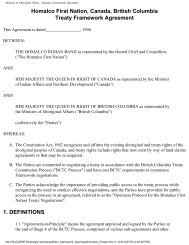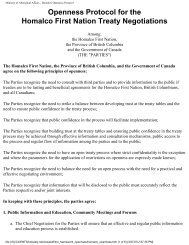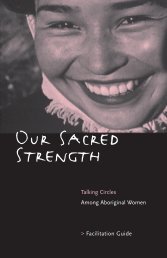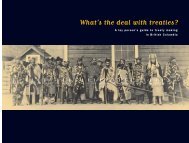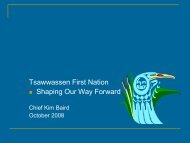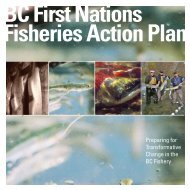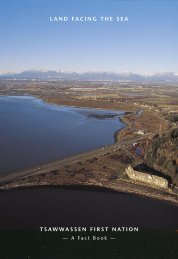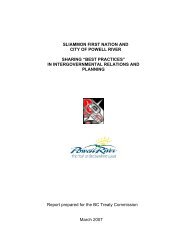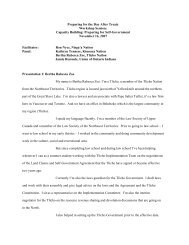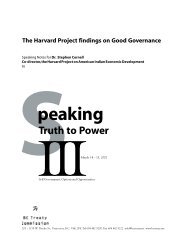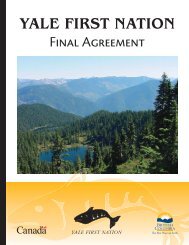Self Government—the Ktunaxa/Kinbasket experience (pdf)
Self Government—the Ktunaxa/Kinbasket experience (pdf)
Self Government—the Ktunaxa/Kinbasket experience (pdf)
Create successful ePaper yourself
Turn your PDF publications into a flip-book with our unique Google optimized e-Paper software.
<strong>Self</strong> Government —The <strong>Ktunaxa</strong>/<strong>Kinbasket</strong> ExperienceSpeaking Notes for Chief Sophie Pierre, St. Mary’s Indian BandAdministrator <strong>Ktunaxa</strong>/<strong>Kinbasket</strong> Tribal CouncilpeakingSTruth to PowerIIIMarch 14 – 15, 2002<strong>Self</strong> Government: Options and Opportunities203 – 1155 W. Pender St., Vancouver, B.C. V6E 2P4. Tel 604 482 9200. Fax 604 482 9222. info@bctreaty.net. www.bctreaty.net
<strong>Self</strong> Government — The <strong>Ktunaxa</strong>/<strong>Kinbasket</strong> Experience, Chief Sophie PierreI’m here to share the <strong>Ktunaxa</strong>/<strong>Kinbasket</strong> <strong>experience</strong> as we live it today. But, before I start I would like to acknowledge andthank the Coast Salish people for allowing me on their traditional territory today. I would also like to thank the BC TreatyCommission for the invitation to participate in this conference on aboriginal self government options and opportunities.For those of you who don’t know me, I’ll briefly tell you who I am. I am the administrator for the <strong>Ktunaxa</strong>/<strong>Kinbasket</strong> TribalCouncil, which represents four Indian bands, Indian reserves of <strong>Ktunaxa</strong> people and one Indian band of an offshoot of theShuswap people, the <strong>Kinbasket</strong> family.We live in the beautiful southeast corner of British Columbia, in the Rocky Mountain trench. Our traditional territory is about27,000 square miles and historically included portions of Alberta and the adjacent states of Idaho, Montana and Washington.We also have two communities today of <strong>Ktunaxa</strong>, one in Idaho and one in Montana. Our <strong>Ktunaxa</strong> language is referred to asa cultural isolate — a language unique to the world. It is one of 11 aboriginal languages in Canada.I am the elected chief of our largest community: A’qam, also known as St. Mary’s, which is located near Cranbrook. Like manyFirst Nations, we elect Chief In Council and the community governments in turn govern our Tribal Council. I am theadministrator for our Tribal Council, which administers a wide range of social, cultural and economic programs offering theusual range of government services. We also have the usual challenges of human capacity, fiscal constraints, downloadingof government programs and a restrictive legislative framework common to most Aboriginal peoples.I could go on with my description, but I know our particular challenges are not unique within Aboriginal communities nomatter where we live. The topic of aboriginal self government is vast and there’s a lot of ground to be covered. Today, I’llconfine myself to speaking about the <strong>Ktunaxa</strong> concept of self-government, a description of the foundation of our society,the four pillars of our society, how we articulate our governance interests and a snapshot of our ongoing nation buildingprocesses.I will also try to describe the evolution of our citizen consultation process, which plays a key role in all of this, and I’m told isconsidered to be quite innovative. Lastly, I’ll mention the obstacles and political challenges that seem to be getting in theway these days. Our work in nation building —which equates in many ways to building self government — has beenongoing for many years now. Our discussions have been wide ranging and both internal and private and external anddeliberate. Many of the panelists today have met with <strong>Ktunaxa</strong> peoples in some form or other related to self-governmentwork, and it’s really nice to see all of you again.Our discussions have been somewhat more focused in the past three years since we have entered into substantive treatynegotiations. Right now, like the majority of aboriginal peoples who are involved in the treaty process, we are engaged instage four, agreement-in-principle negotiations. Although for the past year our tripartite discussions have slowed to a virtualcrawl due to the political challenges unilaterally imposed on our table by the British Columbia government.I wanted to briefly mention the political challenges up front, because despite the political roadblocks we recognize that westill have to continue our internal work toward building effective self-government and to rebuild our Nation. The <strong>Ktunaxa</strong>concept of self government is really quite simple.<strong>Self</strong> government means being responsible for one’s self. The ‘self’ in self government are <strong>Ktunaxa</strong> in our case. That’s all we’retalking about. Like Aboriginal people all over the world we feel we have the right to be responsible for ourselves, but moreimportantly, we know we have the responsibility to be responsible for ourselves.What makes a society? How do you recognize a society? We believe there are four main characteristics, four pillars, if youwill, like the four directions. These pillars represent our land, our people, our language and culture and our governancestructure. It’s pretty the much the same the world over. When you threaten one of these, as we see in the Middle East, it leadsto war. The ability to govern is the heart of any nation. In our contemporary world this is always the understanding: we allexist within a broader context that places limits on our internal decisions.We, the <strong>Ktunaxa</strong> people have governed ourselves, followed our cultural beliefs and traditions since beyond time in memory.Traditional leadership roles and responsibilities have always been tied to a collective survival. Each citizen understands theirrole and value within their community and tribe and respects the role and the value of other citizens within their tribe.1Speaking Truth to Power III
<strong>Self</strong> Government — The <strong>Ktunaxa</strong>/<strong>Kinbasket</strong> Experience, Chief Sophie PierreBuilding on the individual’s strength and knowledge is one of the foundations of our governance. However, our ability toexercise full governance has been limited by the relatively recent imposition of the Indian Act. The imposition has forceda great deal of difficult change and adjustment within the nation. This new system of governance is deeply flawed for oursituation, and I argue it is flawed for all aboriginal people in Canada. New distributions of power and authority have createddeep divisions within our communities.One of the most difficult realities that we face is that our previous method of governance, the <strong>Ktunaxa</strong> governance hasbeen largely lost through the legislated restriction of First Nations cultural practices within Canada. As we redevelop ourgovernance system, we face an enormous challenge because we have to consider how to blend, first of all, our relationshipwith and within Canada and British Columbia. Secondly, community comfort levels and the new distribution of powers andauthorities and expectations created under the last century of governance under the Indian Act. And lastly, elements ofhistorical government structures and powers that have withstood the passage of time. We need to be creative on how weblend those three areas.We recognize there are many challenges in developing governance methods to replace current governance structureswithin our communities. However, we have evolved and adapted through many upheavals and we are confident that wewill continue to grow and change to meet these challenges. Before I begin talking about how we’ve approached thenation-building process, I’d like to describe our citizen consultation process, for much of our collective and collaborativework takes place within this citizen consultation process.Under the new tripartite treaty process we filed our statement of intent in 1993, spent much of 1994 and 1995 gettingready to negotiate and finally by 1996 we’re negotiating our framework agreement. At this time we had an administrativestructure in place under the umbrella of the Tribal Council. We employed band treaty coordinators who worked out of theoffices at the band level.The treaty coordinators held family circles, community dinners, met with Chief and Council and worked a variety ofstrategies and approaches to build citizen interest and input into the process. But we discovered that amid the day-to-dayissues and the priorities of each community, it was evident that treaty negotiations were being treated just like anotherprogram, no matter how worthy our work was.Around 1996, we began holding what we now call nation meetings, sponsored by the Treaty Council Department of theTribal Council. At a summer meeting held high up in the mountains the decision was made to reorganize our treatydepartment and transform it into a proper council. We wanted to make it more accountable to the citizens beyond theaccountability of operating as a tribal department.A ratification process for the future treaty was built by consensus. It began with a series of guiding principles which include,first and foremost, all citizens will have the opportunity to participate regardless of where they reside. The treaty process isa nation-driven process — all citizens will be consulted on all aspects of the treaty. All citizens will be well informed, alldecisions will be made in the best interests of our land, resources, culture, language and the future of the nation.Built into the ratification process is a very high goalpost. Ratification of the agreement in principle will require 60 percentplus one of all our enrolled citizens. Ratification of the final agreement will require 75 per cent plus one of all enrolledcitizens over the age of 16. We recognized early on that with these targets we needed to build an all-inclusive process.Our thoughts are that we need to move our people along in their understanding and common vision at the same time andthe same pace as the negotiations. In this manner, when we get to ratification of the final treaty, if ever, our ratificationprocess will be a formality as everyone will have been included. We recognize it is an idealistic goal, it will be difficult toachieve, but it is the <strong>Ktunaxa</strong> goal.In January 1997, our new Treaty Council continued operations, we hired a treaty administrator, a communications andcommunity liaison coordinator and other staff. We began to round out the negotiation team, added community liaison staff,expanded the lands and resources team. We hired an archivist, built more administrative capacity and began training acapacity building program that covered everything from principled negotiations to group facilitation skills for the team.2Speaking Truth to Power III
<strong>Self</strong> Government — The <strong>Ktunaxa</strong>/<strong>Kinbasket</strong> Experience, Chief Sophie PierreThe treaty staff have outgrown two of their premises to date and are temporarily renting a former billiard hall in Cranbrookas their headquarters. A community education and citizen involvement process has evolved over this time. The TreatyCouncil sponsors community meetings in all five communities on a monthly basis. It’s the forum to review treaty relateddocuments, refine collective interests on topics and generally keep on top and review what’s going on. There are also youthliaison workers who hold meetings with the youth, although their involvement is not limited to a separate forum.We very much take to heart the message that we heard. It’s almost two years ago now, since Stephen Cornell, co-directorof The Harvard Project on American Indian Economic Development, first came and worked with our Tribal Council. At thattime Stephen said “investment must not be thought of as just a financial investment, but as a human investment and ouryouth have to believe that they need to invest their life within our communities”.Within our nation we use another forum we call the Treaty Council. The Treaty Council meets on a monthly basis andmembership is open to any citizen of the nation. The Treaty Council’s role is to help guide the scope and pace of thenegotiations. This forum is an opportunity to bring people together on a regular basis from all of our communities to discusscurrent treaty matters.It gives people a chance to see and hear opinions from other communities. Through these forums we first built a respectfulconversation and then we began to work on building a collective vision. From this common vision, we then built consensusfor whatever the topic or issue we may be discussing. Of course, our internal views are then tempered and modified by theviews and interests as a result of negotiating a treaty on a tripartite basis. And this is built into the citizen driven process also.Our citizen-driven process took a long time to develop — it’s not a perfect process and we are constantly refining andadjusting how we operate. We regularly use another forum as well, we call them nation meetings and they are held everythree months, give or take.We tend to use the Nation meetings for educational and information-related presentations, as well as breakout andfacilitated group work sessions. The theme of our nation meetings over the past three years has been building tribalgovernment and we continue to discuss the future government, constitution, citizenship and common vision for ourNation.As I examined the speaker’s list, I recognized several names in the cast of presenters. We’ve had John Graham, ClaireMarshall’s colleague, from the Institute of Governance at one of our past nation meetings, and of course we’ve met withStephen Cornell and Manley Begay from The Harvard Project on American Indian Economic Development. We’ve also hadpresenters from the Nisga’a Nation, to inspire us with what they are doing, amid a wide range of other presenters.We tried to lower or eliminate as many barriers as we can in order for our citizens to participate. We provide a travelallowance for our citizens to attend the Treaty Council meetings, and we also pay a small honoraria for the work done.While this has proven to be a controversial topic within our nation, it represents a payment for work done. One of thecontinuing concerns with the treaty process is the fact that we are using largely borrowed money to negotiate a treaty, andwe don’t have the luxury of independent funding. We certainly don’t spend big bucks on lawyers and consultants, as we’retruly trying to build a treaty from the ground up.Our nation meetings have become large events that attract anywhere from 200 to 350 people within our nation. We are asmall tribe, about 1,500 or double that once we use our own citizenship code instead of the Indian Act, and to gather 200to 300 people regularly is a remarkable feat. Within our territory there are only so many facilities that accommodate thislarge crowd for a two or three-day meeting, and that in turn leads to all kinds of activities, such as event planning. Weprovide daycare so, that again, to make sure that people have every opportunity to participate in the discussions. We plansocial and cultural events at each of these meetings.The price of building consensus for the future is a price…all of this activity is the price for building consensus for the future.It’s the price for building tribal governance. We’d rather pay this up front than wait until it’s time to ratify a treaty. It’s not aperfect process by any means, we could employ 50 community liaisons workers rather than the seven we have at present,and still not everyone would feel fully informed.3Speaking Truth to Power III
<strong>Self</strong> Government — The <strong>Ktunaxa</strong>/<strong>Kinbasket</strong> Experience, Chief Sophie PierreWe’re dealing with complex topics, and as we continue through negotiations the topics begin to multiply.Building our tribal interest papers take several months on average, as we review, consult and modify interests based on ourcommunity consultation process. To give you a bit of a hint of how difficult this process can be, I will relate one briefexample.When we began to build a wildlife interest paper, and wildlife is a topic that our people know a lot about, we thought thiswas going to be an easy one that we could start with. The discussions in my own community were pretty interesting. As ourtreaty workers began their community discussion they always needed a starting point, but need to balance having toomuch information on paper against not giving enough information. We need to let the information flow and build from acommunity level.So when the wildlife discussion started, one of our citizens stood up and basically said: “Wildlife is not on the table. Do notdiscuss wildlife. I have a God-given aboriginal right to hunt any place and any time I want to, and I’m not going to give thatup.” Then he sat down. There was applause. Then his neighbour stood up and said: “The elk are in trouble, their habitat isbeing destroyed. We need to put a five-year moratorium on hunting elk.” And we thought this was going to be an easy topicto start with.It gave the community some pretty wide goal posts to begin their discussion and discovery of common interests. I can’thelp but get somewhat reflective and philosophical about our approach, for no one process or solution works well all thetime in all or in any of our communities, for that matter. One of our resource staffers noted at a meeting one time: “Theworld is run by those who show up”. Well that sounds like a good message. You want to have your say, you show up at themeeting.As that message was repeated at another meeting, my son, Joe, stood up — and at 6 feet seven inches, when Joe standsup you notice him. He stood up and challenged that notion and basically said “We cannot, we must not allow to leave onecitizen behind in the treaty process.” This sentiment is captured and embodied in our ongoing capacity building work.A parallel theme carried out by the Employment and Investment Department is nation building, one citizen at a time. Ouremployment and education specialists have been conducting individual and occupational training plans for every citizenwho chooses to go through the evaluation process. It takes courage to go through the evaluation process.So far, about one quarter of our citizens have been evaluated and have made subsequent life choices related to their future,their education, their career and their place within rebuilding our nation. It’s been an awesome and an empoweringprocess.The capacity-building process is one of those over-arching activities that take place on a multiple level simultaneously.Communities, departments, programs and funding sources come and go, and the early bird truly does get the worm. It’s allabout building human and technical capacity — from land-based information systems that include state-of-the-art geographicinformation and traditional use database overlays, to drafting a new nation constitution.The baton of Treaty Council governance has been passed on from the <strong>Ktunaxa</strong>/<strong>Kinbasket</strong> Tribal Council Chief’s Council asa functioning department of the Tribal Council to a new and separate entity called the Treaty Council Financing SocietyBoard. The role of this legally incorporated board is to help with administration, policy and personnel and to assure thatfunding is in place to carry out the work of treaty negotiations.Overall, governance of the treaty department is controlled by members of the Treaty Council, not the elected body withinthe Tribal Council. Although the Tribal Council and community bodies are expected to bring their leadership skills to thetable, the ongoing work of Treaty Council cannot happen independently of the rest of the nation-building work going on.It’s a real challenge to integrate and coordinate all of these efforts and we’re slowly figuring out how best to do that.As negotiations continue to expand into more topics, the Treaty Council is slowly building greater departmental involvementin technical discussions, such as: building work plans that integrate work into the greater workflow of tribal business;working groups that deal with technical subjects; and other topics, such as governance or citizenship continue to work to4Speaking Truth to Power III
<strong>Self</strong> Government — The <strong>Ktunaxa</strong>/<strong>Kinbasket</strong> Experience, Chief Sophie Pierrebuild and implement various elements of our nation-building strategies.Our main challenge is to ensure that the direction we move into has the full support of our citizens and our communities.As a leader for over 20 years, I am personally encouraged that our citizens are becoming more and more engaged inbuilding our collective vision for the future. I said earlier that self government is being responsible for one’s self.A good example of the progression outside of the treaty would be in the area of child and family services and the delegatedenabling agreement we signed in 1999 — a first step in pre-treaty implementation of governance jurisdiction and authorityrelated to child welfare within our nation.Readiness work and capacity building have taken place for many years and the agreement for delegation of provincialauthority for child welfare services is occurring over several phases, and will eventually result in full responsibility to providesupport and protection services for children and families. Although this governance authority will be reflected in one ormore chapters of our final treaty, right now it’s an agreement between our child and families services society and theprovincial and the federal government.Our work in defining our collective vision supports all of this work. Communities know what is best for our children and itis our children who are the future of our nation. This transference of governance, means that children will have safe, secureand culturally appropriate family and community <strong>experience</strong>s.This parallel work conducted on a departmental or program level is an important element of our continuing preparation forimplementation of a treaty. The results of our citizen consultation form the negotiating mandate for our negotiators.Negotiations are a process of give and take and we often have to consider other interests as we build our vision for thefuture.There are many challenges ahead, and many mistakes are made along the way, but we must persevere, for treaty negotiations,according to our perspective, is really a process of rebuilding our nation.I have to mention one important contradiction. At the negotiation table we say we are trying to build something new. Thisis supported by all three parties, building something new. Build a new relationship on a government-to-government basis.Yet, having said this and being committed to this principle, we are largely dealing with government who are not able tothink outside the box. Government mandates often represent or reflect the existing statutory or regulatory status quo andthere’s not a lot of room to build either something new, something innovative or to allow space for cultural differences.Having said this and considering that negotiations have been all but stalled for the past year due to the transition of a newprovincial government and a related set-aside of negotiating topics, such as governance and jurisdiction, they are creatingsome critical problems. Ultimately we would prefer to negotiate rather than litigate.I think current events should be considered to be a wake-up call for the British Columbia government. The on-going workof Treaty Council cannot happen independently of the rest of the nation-building work that is going on.It’s a real challenge to integrate and coordinate all of these efforts, and we’re slowly figuring out how best to do that. Ourpeople have seen many governments come and go over the past 125 years, and we’re still here. BC’s current approach totreaty negotiations and delegated forms of self government represent a dramatic shift in government policy and willpresent us with major challenges in the months to come, as we strive to continue to build a new relationship based onmutual trust and respect.There is so much more that I would like to discuss. I particularly love to discuss economic development and our new $40million St. Eugene Mission Resort, Casino, championship golf course — all that will open this summer and the golf coursewill re-open in April. But, I guess I’ll save that for another day and another forum.I just want to say that you have a standing invitation to come and visit us at St. Eugene and to come and golf at what GolfDigest has described as one of the best new golf courses in Canada. I guess Golf Digest is to be believed.5Speaking Truth to Power III



